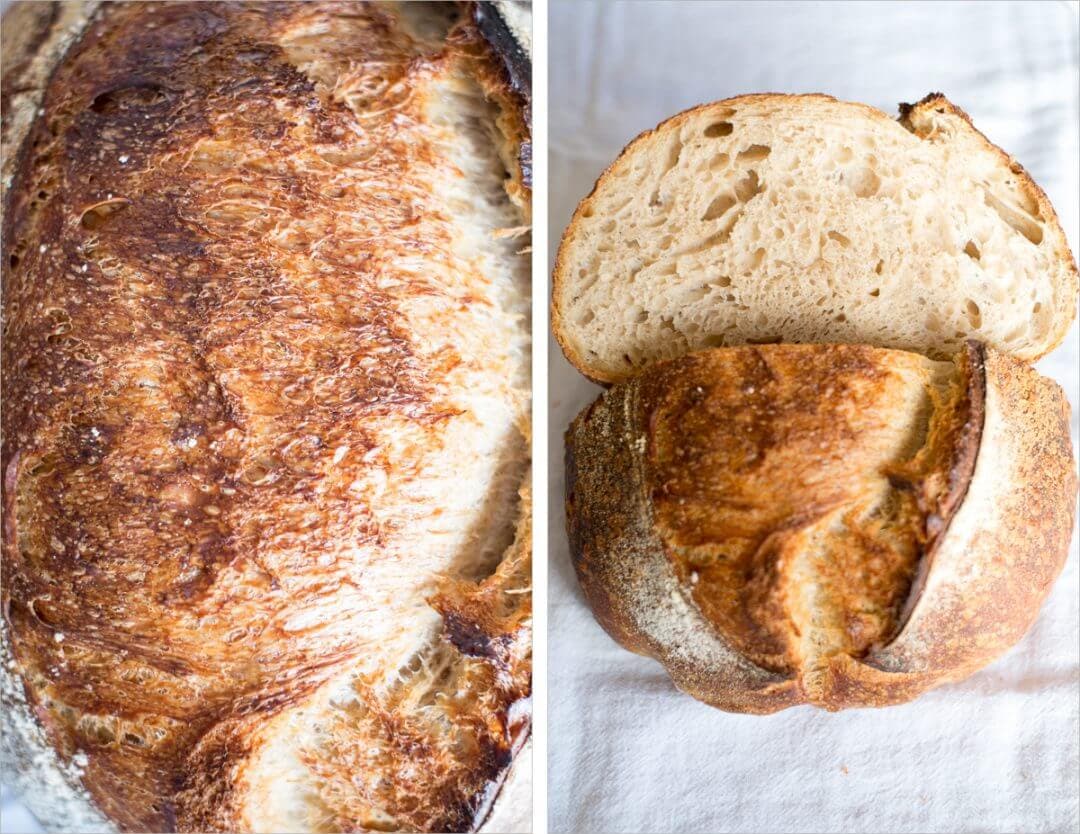The following quote, a poignant and relatable statement from Lapo Elkann in a recent Monocle magazine interview. In a relatively jovial and concise article, he talks about what good food means to him and his family and how it is the center of his daily ritual. In the same fashion, food to me is usually the center of my day and my interactions with my family and friends. I take care in planning and preparing food for each week and am generally planning out my week’s worth of baking and cooking well before it arrives. My kitchen tends to revolve around what I receive from our farmer’s market co-op which makes things interesting—you never know what you’re going to get. Similarly, baking high hydration sourdough bread means a place for experimentation, and this high hydration sourdough bread is the result of several rounds of tweaking and adjusting until the bread came out just right.
I think it’s important to add some pleasure to your life; without it, your creativity won’t be at its best. When the stomach calls, satisfy it. Don’t eat a lot but eat well.
Lapo Elkann
Each week my bread is a chance for me to improve on my tireless quest for the perfect loaf—a search that will likely never end, but it’s the journey that’s the critical part. The perfect loaf, that bread you pull from the oven and sit there for a minute to watch as it cools. The loaf, that when cut, shows a crumb so light and airy you can’t help but poke at it in disbelief. The dark and brittle crust, blisters and cracks along the outside, dynamic tears, and rips on top, the open and light crumb that has an even interior from front to back. Of course, they don’t all end up that way. That’s the hard truth of baking: every bake begins anew. Did bread flop last time? Well, take what you did, modify a single variable, and give it another try and compare what worked and what didn’t. This truth is both very frustrating and also very comforting.
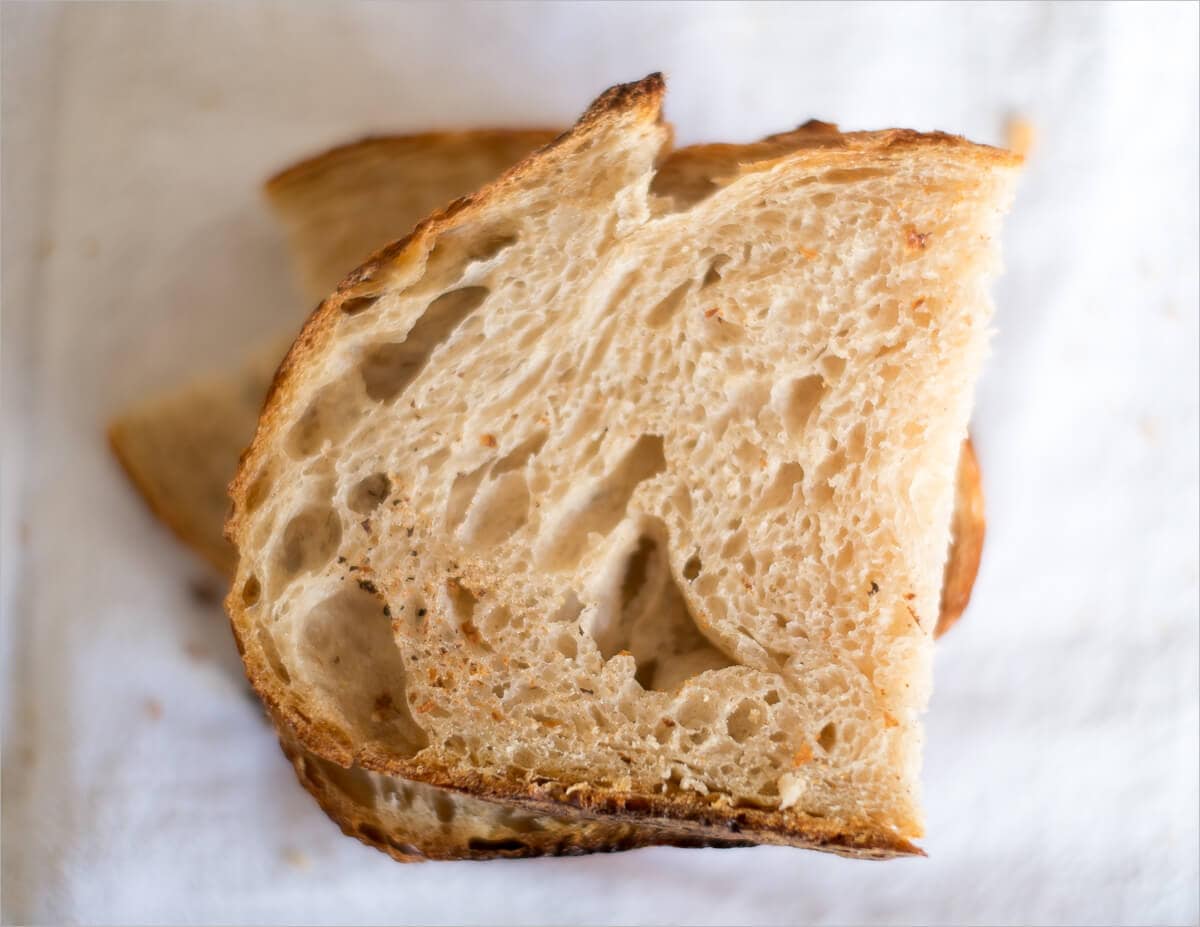
Ok enough of the philosophical treatise on bread and artisan crafts, let’s get on to the actual baking!
The bread I set out to bake for this entry pushed my comfort zone with hydration, a high hydration sourdough bread at 80%. I know that to get the open crumb I’m searching for, hydration has to increase, so I’ve decided to increase the hydration level without making any drastic changes. Shaping becomes incredibly difficult as you get up past 80%. It becomes very sticky and a little slacker. The next few entries, much like this one, will result in some less-than-perfect results (still tasty, however).
And to be clear, I’m not pushing dough hydration just to push it high in an attempt to reach some number. It’s an experiment to see how the increased water effects the texture, fermentation, and eating quality of the final loaf. Does it make things better? If so, we’ll keep moving in that direction. If it doesn’t make things better? Back off and reevaluate.
Prepare the leaven – 10:15 p.m.
My typical 100% whole wheat leaven, prepared the night before:
- 30g ripe starter
- 120g whole wheat flour
- 120g water
After mixing the above in a glass container, cover and set in a slightly warm area in your kitchen. If it’s cold at night at your place like mine (around 65°F/18°C at night), you’ll need to experiment with an area that’s a bit warmer in your kitchen. For me, it’s on top of my refrigerator.
If you haven’t yet created your sourdough starter, don’t fret, it’s very simple. Head over to my post where I discuss creating a sourdough starter from scratch very easily in 7 steps.
Mix the flour and water, autolyse – 10:00 a.m.
Even with the warmer temperatures on top of my fridge, my leaven still needed more time to mature. I’ll usually start around 8:00 or 9:00 a.m. but the “nose” of my starter was not quite sour enough, and it could use a few more visible bubbles. At around 10:00 a.m. things looked much better and I started for the day.
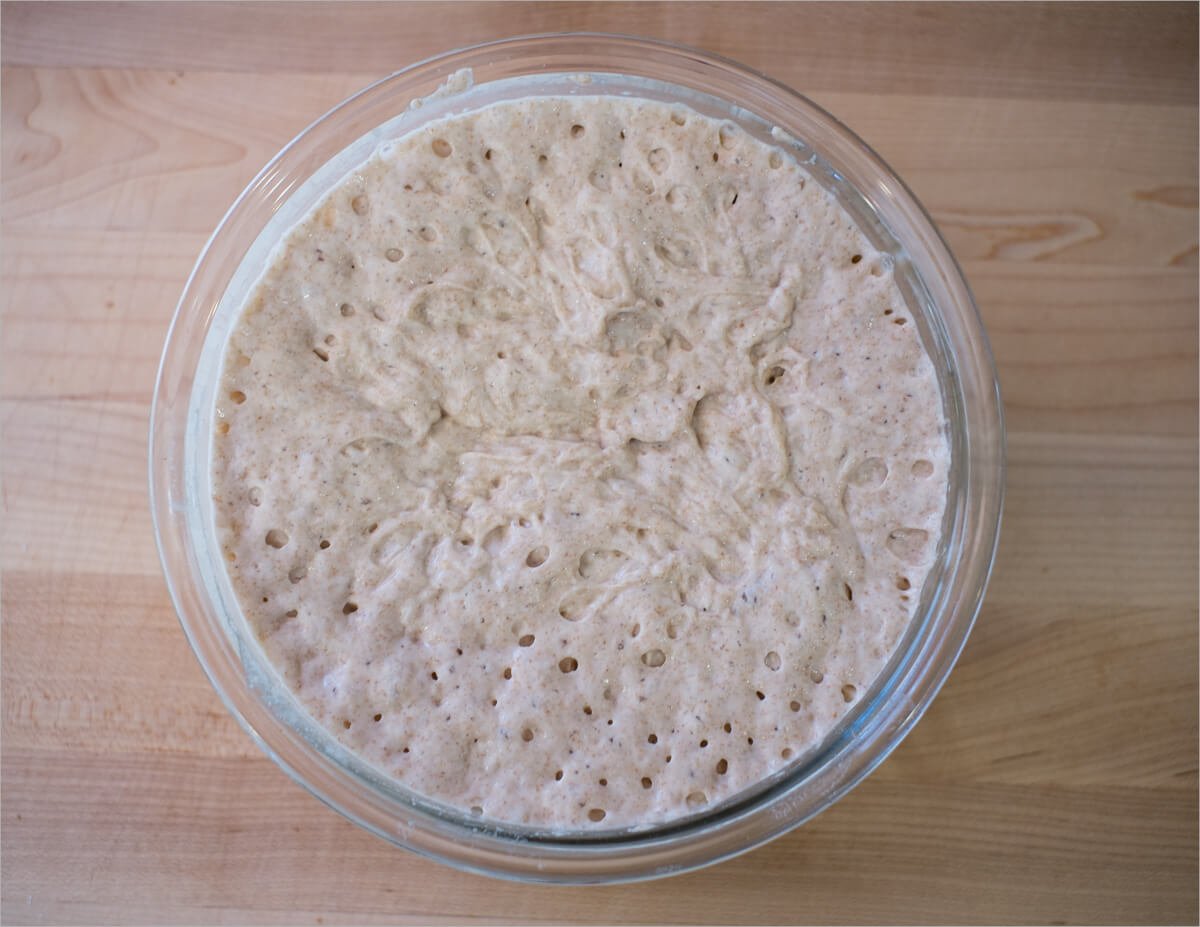
I did a quick verification with the “float test,” scooping just a bit of my starter into a glass full of room temperature water – looks like it’s floating, we are ready to go. I don’t usually do the float test at this point anymore, but sometimes it’s a good sanity check to make sure things are progressing as expected.
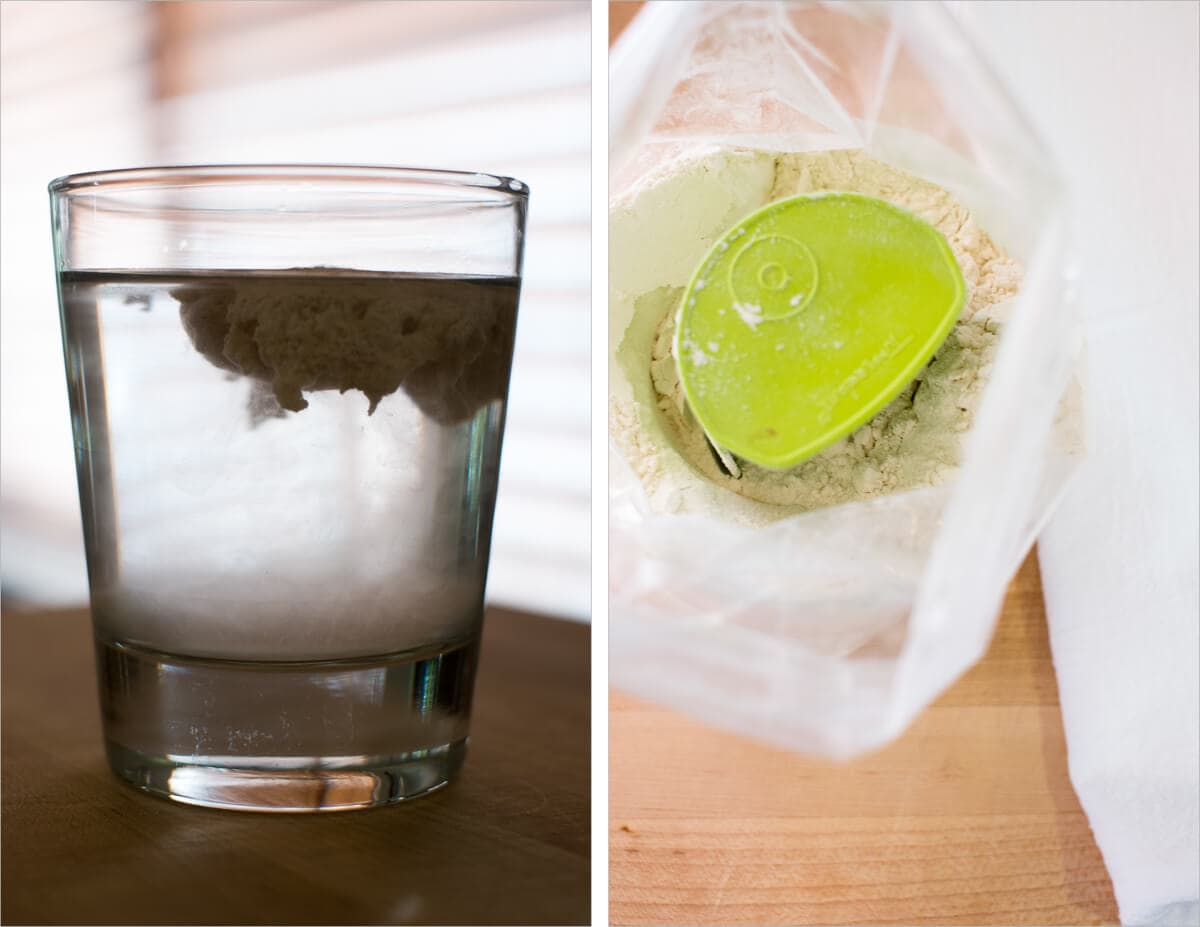
Ingredients:
- 250g (25%) leaven
- 800g (80%) King Arthur bread flour
- 200g (20%) Great River Organics whole wheat flour
- 20g (2%) salt
- 750g and 50g water in reserve for the next step
I recently discovered that I’m a bit lucky here in New Mexico as we have a tremendous local flour mill that produces white flour from wheat grown up north around Taos. This Sangre de Cristo flour is available at some local co-ops, and I hope to have some to test with for the next entry. I thought I was out of luck and would have to eventually buy my small home mill to have complete control over that part of the process… To be honest, I’m still pining for a home mill and hope to have one in the future.
Method:
- Add the 250g of leaven to a large mixing bowl
- Pour in the 750g water and mix with your hands until the leaven is completely dissolved
- Add 800g of the bread flour and 200g whole wheat flour and mix with your hand until all the dry flour is incorporated
- Cover your bowl with a towel and let autolyse for 50 minutes
- After 50 minutes add 20g salt to the dough and slowly pour the remaining 50g water on top. Squeeze the dough with your hand to incorporate the salt
- Now reach your hand under the dough and pull one side up and over onto itself. Do this several times until you notice the consistency of the dough to turn sticky
- Transfer your dough to a large bowl for the bulk fermentation step
The final dough temperature after mixing in the salt was 78°F (25°C). Perfect.
Bulk Fermentation – 11:00 a.m.
During bulk fermentation, you want to do about six turns spaced out 30 minutes apart. The first four turns should be fairly vigorous with the last two being more gentle as not to push out all the precious gasses built up.
- 11:30 a.m. – Turn 1
- 12:00 p.m. – Turn 2
- 12:30 p.m. – Turn 3
- 1:00 p.m. – Turn 4
- 1:30 p.m. – Turn 5
- 2:00 p.m. – Turn 6
- 2:00 p.m. – 3:30 p.m. – Rest on counter untouched
During the bulk fermentation step, taking place over several hours is usually a perfect place for me to take my dog out for a quick 30-minute walk and a post-walk espresso.
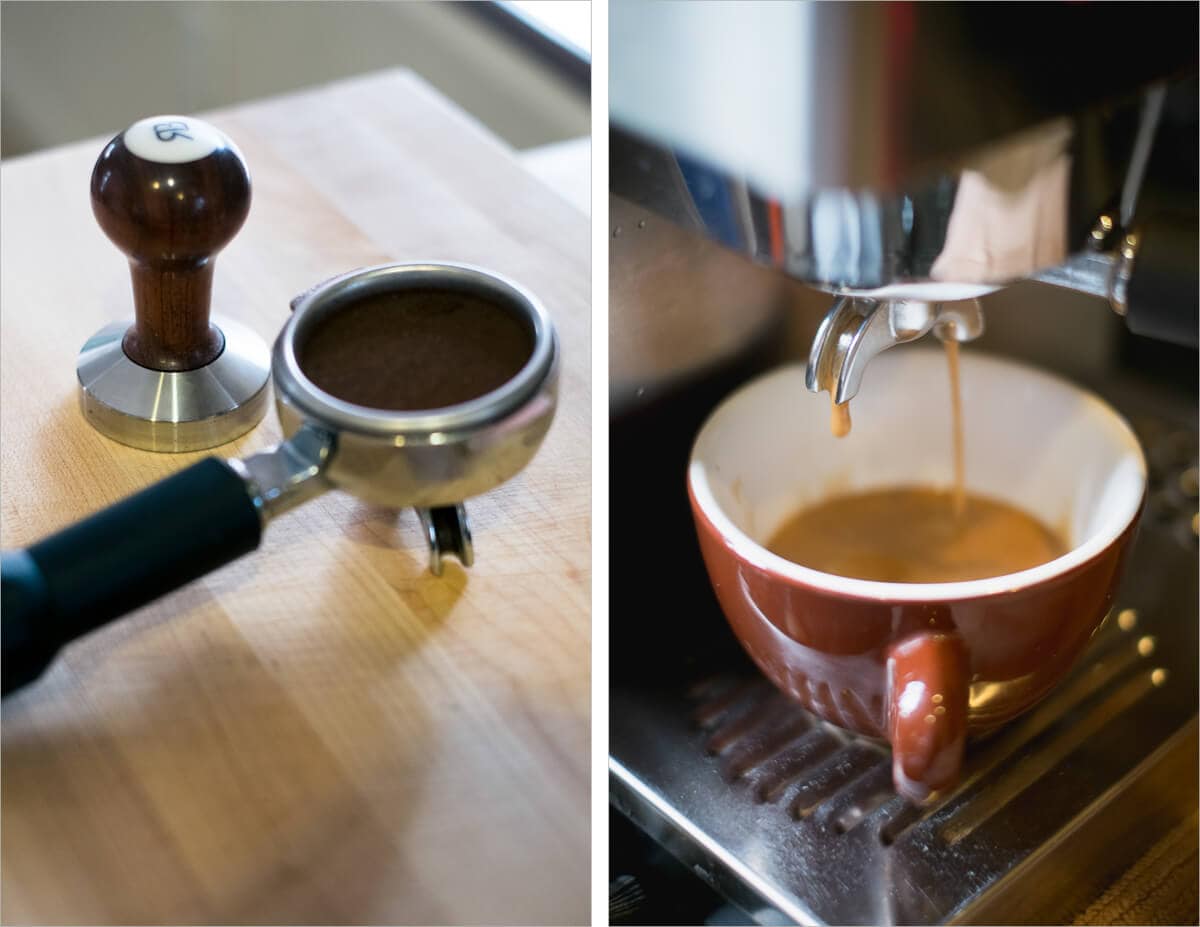
By 3:30 p.m. the dough had risen almost to the top of my bowl, was very bubbly throughout, and was ready to be shaped.
Pre-shape – 3:40 p.m.
Take the dough out of the bulk container onto your work surface and sprinkle some flour on top before dividing. Divide the mass into two halves and lightly spin each half with your dough knife in one hand and your other hand. This will very lightly create tension as the dough sticks to the work surface. Invert a bowl on top of each shaped mass to keep it from drying out and set a timer for 30 minutes.
Lightly dust your two linen-lined bannetons with white rice flour. These bowls will hold our fermenting dough overnight in the fridge to proof (final rise).
Shape – 4:10 p.m.
Due to the 80% hydration of these loaves, I had to be very quick and gentle handling this dough. I floured my hands frequently, but I try not to flour the dough excessively. If you take too firm a hand, you’ll push out built-up gasses, but you still need to shape enough to form that taut outer skin that eventually creates the crust of your loaf.
First, I lightly flour the top of one of the rounds, slide my bench knife under and with my other hand flip the round over so the floured side is now resting on the work surface. I then fold the bottom 1/3 up to the middle, the right 1/3 out and on top over to the left side, the left 1/3 out and on top over to the right side. Then, I finish the “envelope” by taking the top 1/3 out and down over to the middle. At this point, I grab a little of the right side near the top, fold it over to the middle, grab a little of the left top and fold over to seal. I then repeat a little below that and continue onward down the mass. Visually it would look like little “X”‘s running down the top of the loaf. When you reach the bottom, pull up the top and roll it down to the bottom.
Have a look at my boule shaping guide for more pictures of the process, or you could shape this dough as a batard (an oblong or oval).
Proof – 4:30 p.m.
After shaping, gently place the dough into their baskets and the fridge for overnight proof.
Score + Bake – 8:30 a.m. (the next day)
Gather your tools:
Place your empty combo cooker in your oven (I like to place the shallow side to one side and deep side to the other), and preheat to 450°F (230°C).
After one hour, take one of your loaves out of the fridge and cut a piece of parchment paper to place on top of the basket containing the dough. Take your peel and then put it on top of those two and quickly invert it, so the dough is now resting on the parchment paper and the peel.
I had a request in my last post to show what this looks like, and here it is. I’ve found this to be the easiest, safest, and best way to transfer dough to your combo cooker without dropping it in and causing gasses to press out. On the left side you can see my linen-lined banneton on the bottom, a piece of parchment paper above that, and finally, the pizza peel on top. After you quickly invert, you’ll see the right side picture below. Then you lift the banneton off, and your dough is ready to be scored and slid into your pan from the oven.
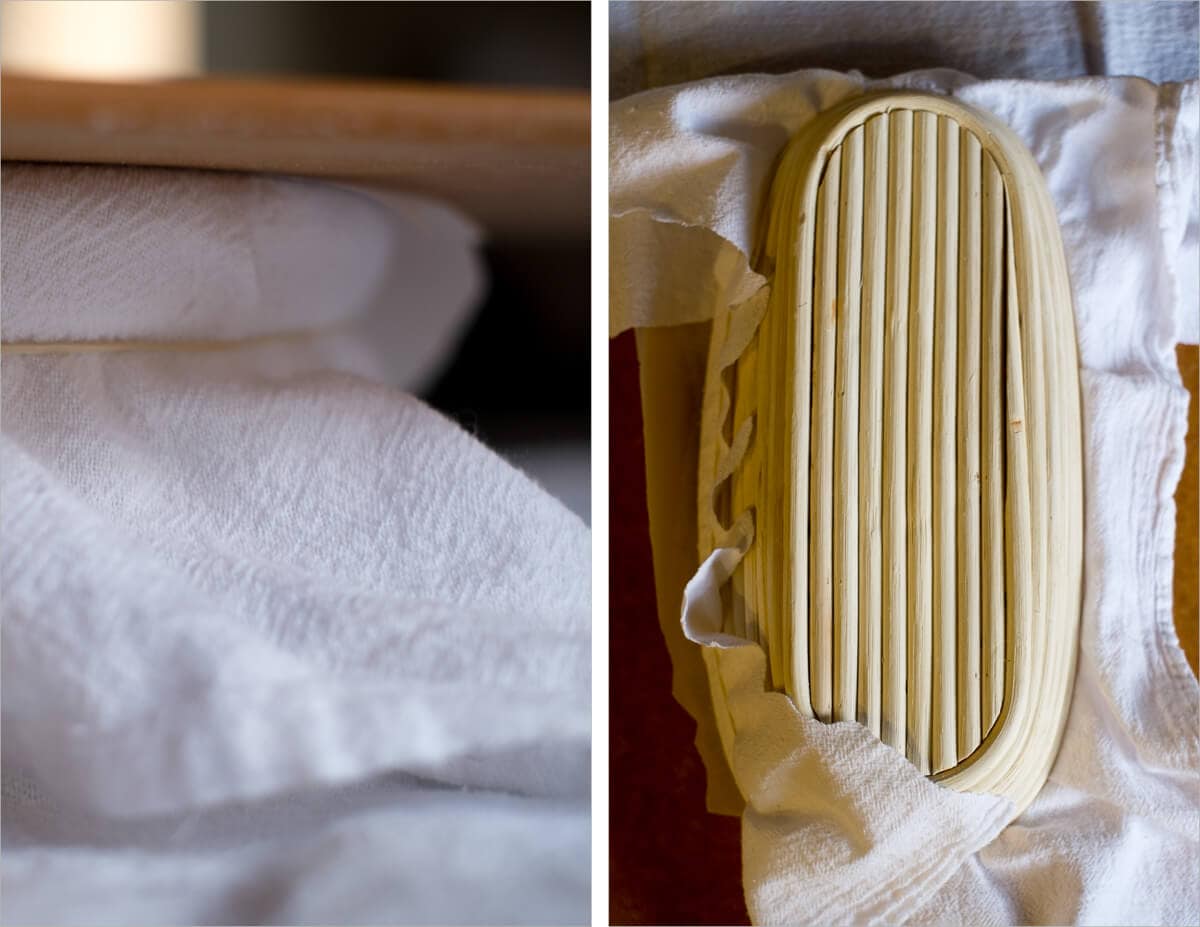
Get your razor blade out and score the top of the loaf to allow the bread to expand while rising in the oven.
Place the dough into the combo cooker and bake, covered, for 20 minutes. After 20 minutes, take the lid off and bake for an additional 35 minutes, until done. This modified baking schedule is something I’ve adapted from Tartine No. 3, their newest book. I’ve noticed this helps to caramelize the crust and cook the dough more thoroughly.
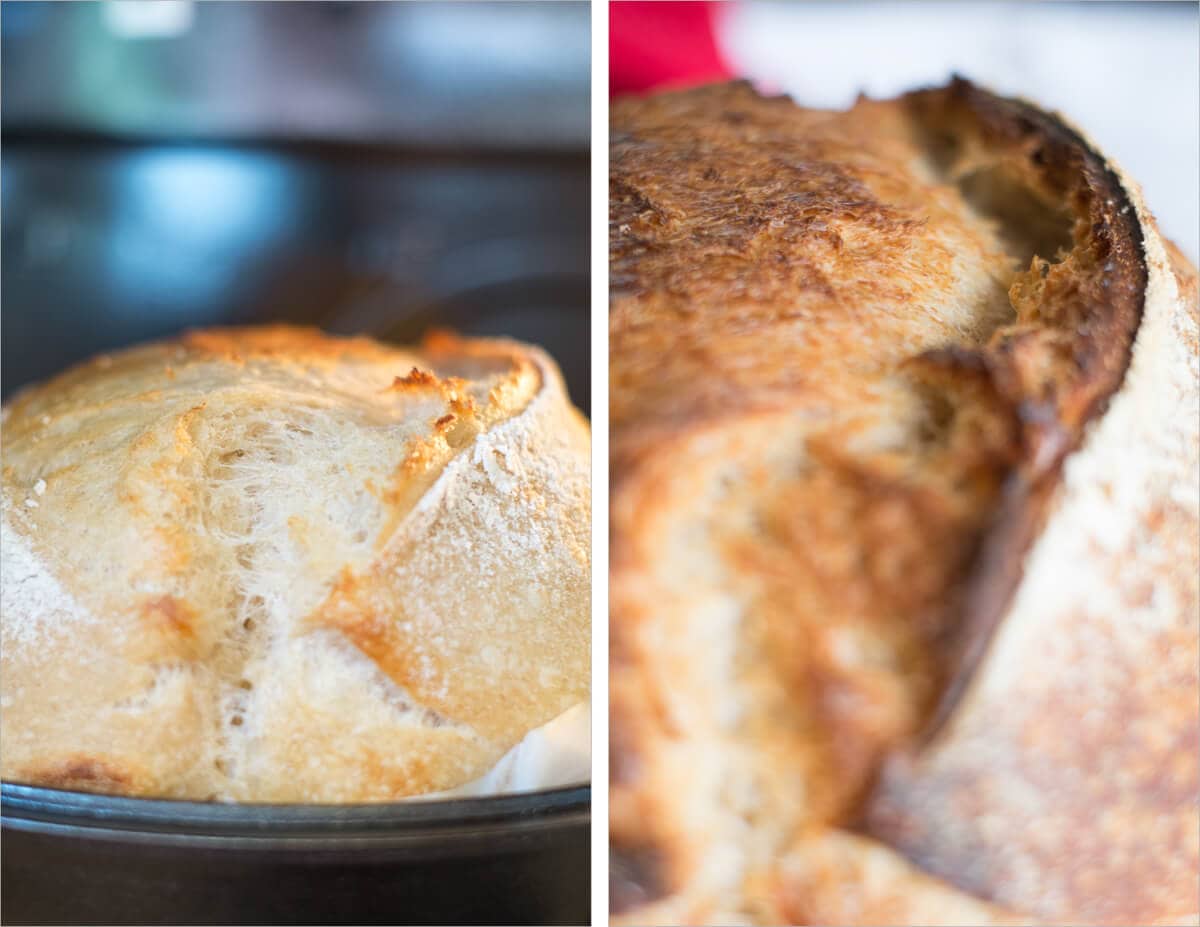
Conclusion
Being one of my first takes at such a high hydration sourdough bread, I’m pleased with the results overall (see my next post on even higher hydration for some better results!). I need to focus on shaping more confidently for the next round to hopefully achieve an even more open crumb. The taste here was an unexpected revelation, the hydration level brings out more of the subtle flavor of the flour used and make the crumb nice and moist for days after baking.
Crust
The crust on this loaf was nice and thin, and colored so exceptionally well. I believe the slightly longer autolyse time of 50 minutes helped out to bring out more of the sugars in the flour leading to more caramelization. The increased baking time also helped to color the loaf a little darker without burning the outside. Those dynamic “tears” on the top of the loaf between the sides of the slash are precisely what I’m after.
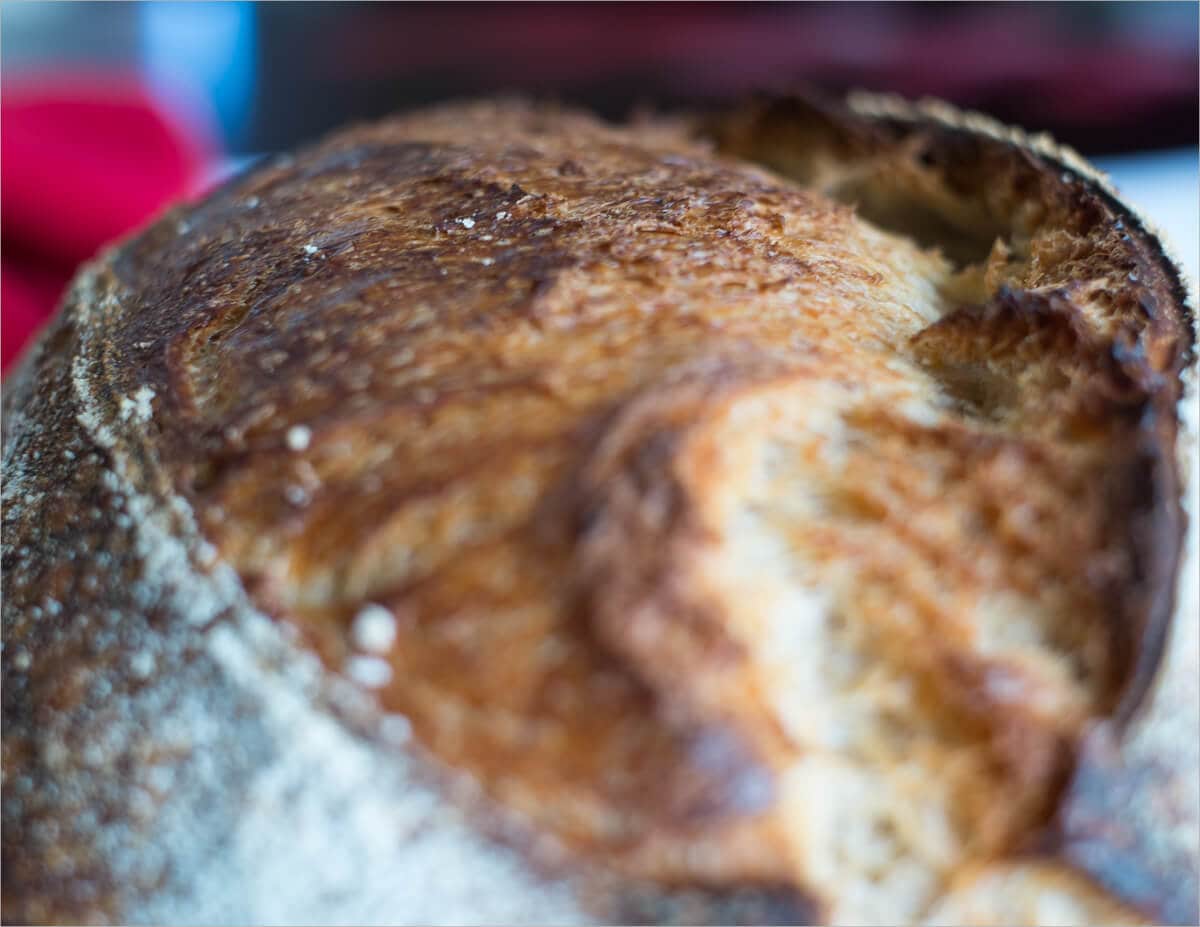
Crumb
The loaf overall was light and airy, but I wanted more openness and evenness to the crumb. While the texture was nice, next time I’m going to test out an even gentler and lighter set of turns for the end of my bulk fermentation.
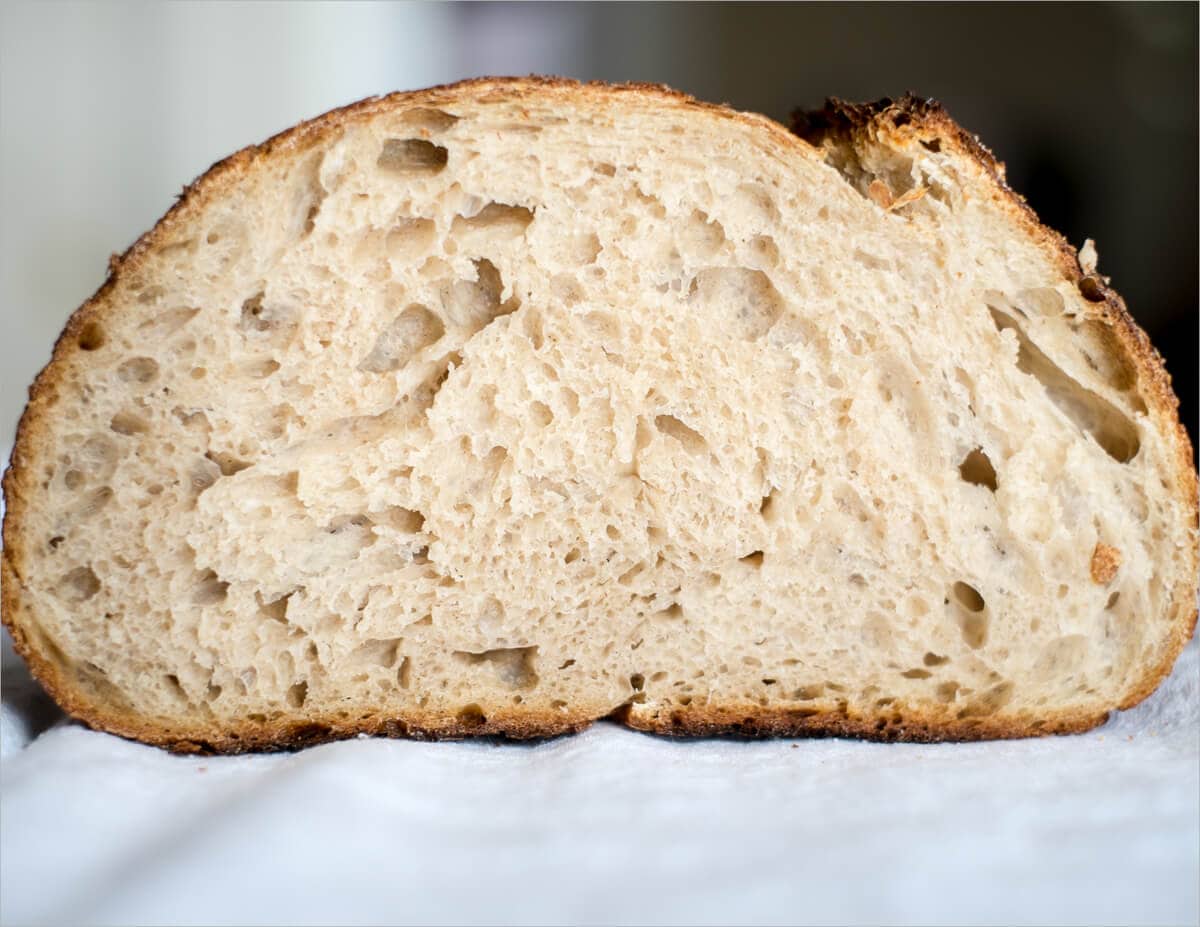
Taste
Very, very good! The taste is always just great, but this one tasted better than usual. I’m attributing this great taste to the nicely caramelized and thin crust. Additionally, the higher hydration imparted a very moist and tender crumb that has me swearing off bread less than 80% hydration in the future.
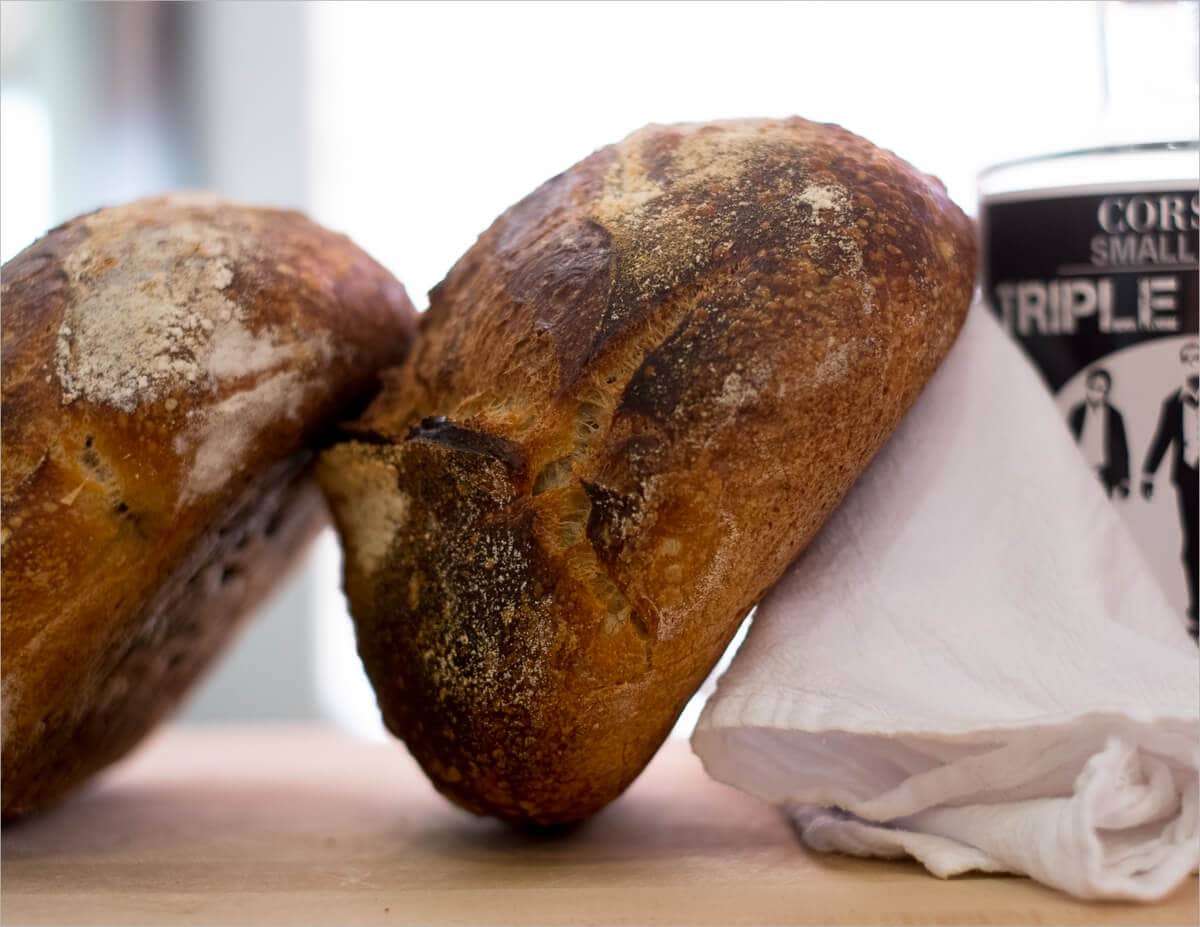
I sliced this loaf up after letting it cool for a few hours and spread on some fresh basil pesto with a few cherry tomatoes for a quick & dirty bruschetta of sorts. A seriously good afternoon snack.
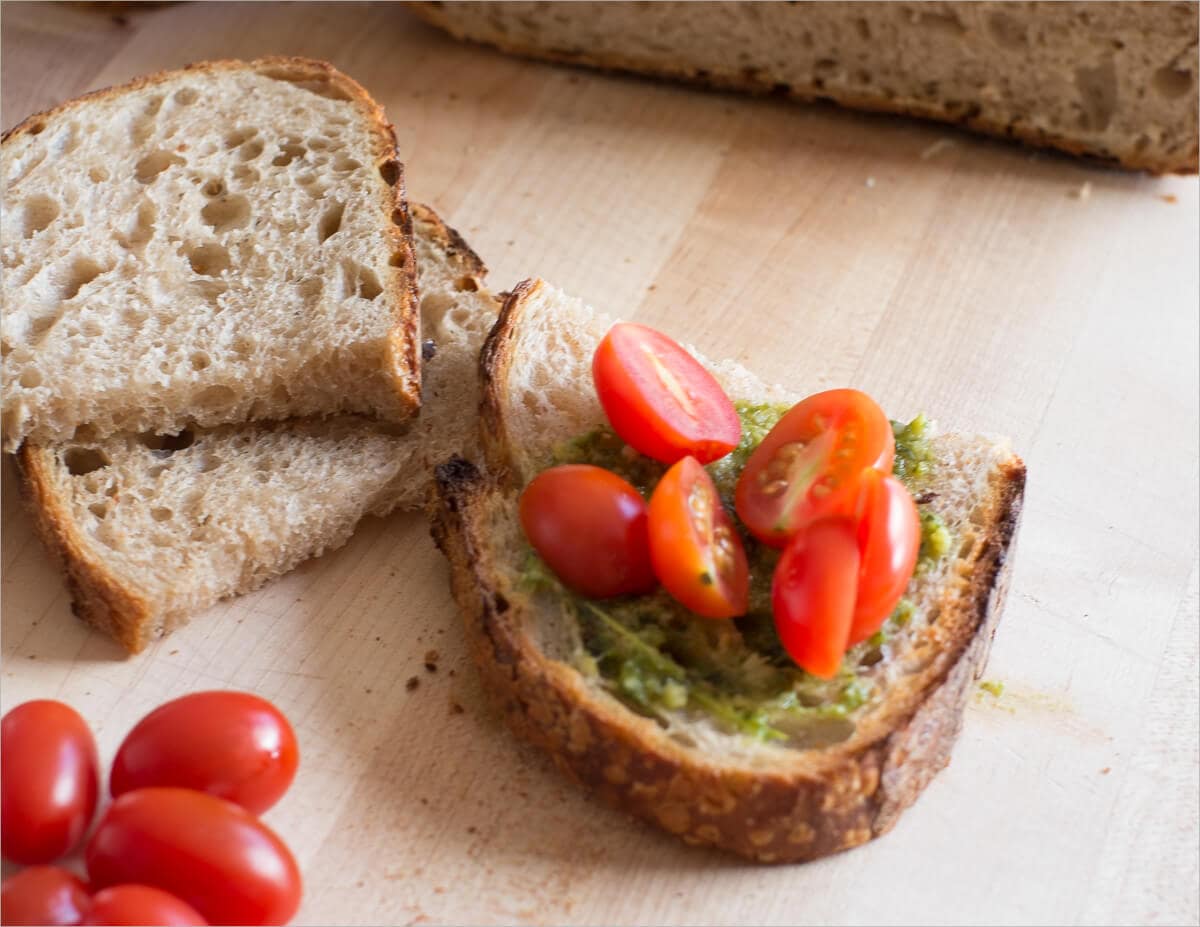
In my next entry I up the hydration even more and get an even more open and tasty crumb!
Buon appetito!
If you use this recipe, tag @maurizio on Instagram so I can take a look!


